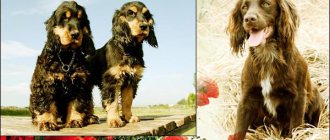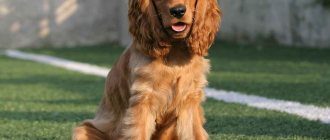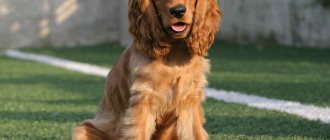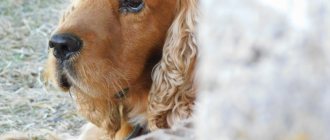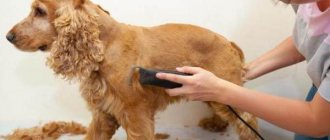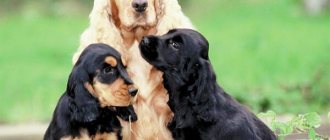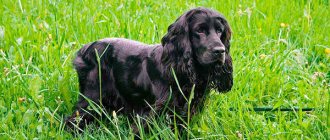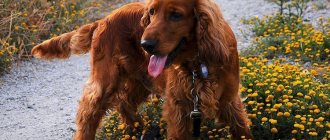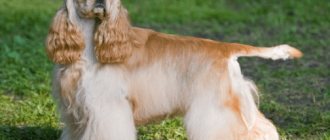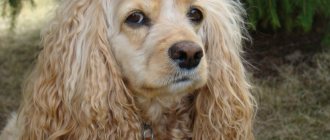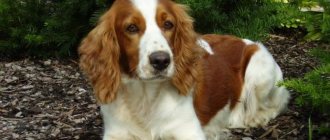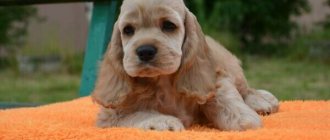Looking at a Cocker dog, few would think that behind its pretty appearance and sad eyes lies an unrivaled hunter with keen hearing and a keen sense of smell. There are different types of this breed, the most popular of which are the American and English cocker spaniel. Both varieties are loved by dog breeders.
English and American spaniels are two breeds that are very similar to each other. It is quite difficult to notice the differences with an unprofessional eye, but an experienced breeder can determine at first glance how the American Cocker differs from his fellow Foggy Albion. What are the differences and similarities between these species and how to distinguish one Cocker Spaniel from another - further in the article.
Care and maintenance
An American Cocker Spaniel will do well in an apartment.
For normal development, the animal requires two-hour walks. Americans are bathed in warm water with shampoos to care for long hair. To add shine to the fur, you can use tinting balms.
Grooming
You can do comprehensive pet care yourself or entrust it to a pet salon. During the bathing procedure, the groomer will not allow water to get into your pet's ears.
A professional will pay attention to the condition and health of the skin and coat. Without proper care, the spaniel quickly becomes shaggy and unkempt.
Hygienic and decorative haircuts must be carried out every 2 months. The master cuts hair from the muzzle, back of the nose, and upper jaw. The fur on the lower jaw is cut as short as possible so that it does not interfere with eating. The croup, back, shoulders are trimmed, the hair on the ears is shortened by two-thirds of the hair length
Without proper care, a spaniel quickly becomes shaggy and unkempt. Hygienic and decorative haircuts must be carried out every 2 months. The master cuts hair from the muzzle, back of the nose, and upper jaw. The fur on the lower jaw is cut as short as possible so that it does not interfere with eating. The croup, back, shoulders are trimmed, the hair on the ears is shortened by two-thirds of the hair length.
- Tomatoes in gelatin for the winter recipes with photos without sterilization
- How to make pasta bolognese at home
- Hijama - what is this procedure? How to do hijama with bloodletting or cupping and contraindications
Hygiene procedures
Standard care for American Spaniels includes:
- bathing;
- combing;
- wool cutting;
- ear cleaning;
- dental care;
- treatment against parasites;
- washing the eyes.
It is recommended to bathe the animal once a week. If you carry out the procedure less frequently, the cocker's coat will acquire an unpleasant odor. The animal needs to be combed daily. Nail trimming should be done every month. The sections are processed with a file.
The cocker's teeth are brushed with a special paste for dogs at least twice a week.
It is not advisable for your spaniel's ears to come into contact with food. It is recommended to tie them up when feeding. You can also buy your animal a narrow and deep bowl so that the fur does not get dirty while eating. Treat your ears with cotton swabs soaked in alcohol or saline solution every week.
Make sure there is no excessive discharge.
Nutrition
American cockers are real gluttons. Overeating can lead to deterioration in coat quality, allergies and other health problems. Feeding the animal from the table is strictly prohibited.
To maintain normal weight and maintain health, it is recommended to give premium food to cockers: Belcando, Organix, Profine, Monge, Blitz, etc.
They contain essential vitamins, proteins, fats, carbohydrates and microelements.
When feeding naturally, the animal’s diet should contain:
- fermented milk products (cottage cheese, kefir);
- lean raw meat (turkey, chicken, beef);
- fish fillet;
- vegetables fruits;
- dog biscuits, bagels.
English cocker spaniel
The English Cocker Spaniel is not as large as the Russian, but has an impressive appearance due to its long, thick coat. Shiny pile covers the body, forming a beautiful collar and “pants” on the paws and a “skirt” in the lower part of the body. The cocker's ears are very long, widening downwards in the form of a drop. A low seating position at eye level is very important. Poor quality wool is considered a disqualifying fault. The dog's build is strong, with a straight back and strong paws. The animal should not be bony or fat. The tail is docked at three days of age.
Cockers have an active, cheerful, and very sociable character. The dog is friendly towards children and does not conflict with other animals. The breed needs good physical exercise and long walks; it is an excellent companion and friend for the whole family.
Photo gallery
Beginning dog breeders often do not know that this breed is divided into varieties. There is an English Cocker Spaniel and an American Cocker Spaniel - two continental twin brothers. Let's look at the photos and try to figure out what their differences are.
Content Features
The English Cocker Spaniel is suitable for living in an apartment, mainly due to its small size. It’s hard to call a hunting dog too clean. She can happily roll around in something or run merrily through puddles. At home, out of boredom, he may bark or spoil things. Keeping them in a private home does not replace the need for regular, long walks outside the yard. Theoretically, a spaniel can live on the street, but psychologically it is poorly adapted to this. Needs communication and attention. In addition, without regular care, the dog will not look its best.
English cockers are very energetic and playful dogs. To maintain good shape, they need a long walk with the opportunity to run freely, regular trips to the field and swimming in the warm season
No less important is the mental component. A variety of training sessions, practicing commands, and search and fetch tasks will help keep a smart cocker occupied.
Care
The English Cocker's coat is long, fine and prone to tangling, so it requires regular brushing.
It is especially important to do this thoroughly during the first shedding, when the dog is about 6 months old. Poorly combed undercoat can negatively affect further coat growth.
Bath as needed. It is better to use special shampoos and conditioners that are designed for this breed. After walks, a dirty dog is only rinsed with water.
The fur between the paw pads is trimmed regularly. Long ears require extra care, as they get dirty when walking and eating. To keep them clean, they are tied up or special caps are used. Claws are trimmed as needed. Monitor the condition of your ears and teeth. Weekly inspection and cleaning is recommended.
It is not necessary to cut a cocker's hair if he does not participate in exhibitions. Many owners limit themselves to combing. Show dogs are cut for the first time at 2-3 months, in order to get acquainted with the tool and then as they become overgrown. Professional groomers can offer several options for summer and winter haircuts for cockers. In addition, hairstyles are divided into home and exhibition. They begin to prepare the dog for the show in advance and cut it according to the established pattern.
Nutrition
Spaniels are usually not fussy about their diet, but you need to pay special attention to portions; they are very gluttonous and prone to overeating. Between the main two feedings you can give dog treats
It is better to avoid products that can cause allergies.
English Cocker Spaniels can suffer from a nutritional form of dilated cardiomyopathy, which is associated with low blood levels of the amino acid taurine. In many cases, the condition is reversible if the dog receives taurine as a dietary supplement.
Table
| American Cocker | English cocker |
| Height at withers | |
| 38 cm (males); 35.6 cm (females) | 39-41 cm (males); 38-39 cm (females) |
| Weight | |
| No weight limit | Recommended – from 12 to 15 kg (the dog is prone to overeating) |
| Frame | |
| Characterized by high forwardness | Flat or slightly sloping back line, smooth descent from the croup to the base of the tail |
| Head | |
| A rounded skull, a dry (chiseled) infraorbital space and a full upper lip. Relatively short, square muzzle with a slight snub nose | The skull is less rounded, the lines of the head tend to be natural. The head is somewhat larger, the ratio of the lengths of the skull and muzzle is approximately 1:1 |
| Wool | |
| Long, reaching to the ground, decorating the hair. A haircut in a certain shape is required | Medium length fringes. A haircut, if done, does not disrupt the natural look |
| Temperament | |
| Impressionable, painfully tolerates loneliness | More balanced |
| Working qualities | |
| Almost lost, appear in isolated cases | Saved. According to the breed standard, field trials are required |
About the breed
The breed is considered to be of native English origin.
As early as the 13th century, dogs such as the Norwich Terrier and the Dachshund were used for hunting. Their main purpose was small game in the swampy thickets and dense forests throughout the territory of the modern kingdom. As already mentioned, a novice dog breeder may not even suspect that Cocker Spaniels come in English and American varieties. The origin story of the latter began with the European conquest of the New World. Many of them migrated there with their pets, including many dogs, and spaniels in particular. Spaniels received the prefix from the most frequently brought prey of the woodcock (wood cockerel)
Until the mid-30s of the last century, these two breeds were not separated, but then English dog handlers insisted on their own. For centuries they have cultivated a high level of performance in animals, paying virtually no attention to appearance. Whereas in America they did everything the other way around. Appearance was put at the forefront, and performance was simply forgotten. This is why the American Cocker Spaniel has a more elegant appearance.
But their colors are almost similar. Read more about this in the articles:
- English Cocker Spaniel colors;
- American Cocker Spaniel colors.
American and English Cocker Spaniel: differences
Externally, both breeds are very similar and this is explained by common roots. But there are a number of differences. Let's take a closer look at how the English Cocker Spaniel differs from the American one.
- Minor differences in height will still help you figure out who is who. An English spaniel will be 5-7 centimeters taller than its overseas counterpart. Its height at the withers is up to 42 cm. Americans rarely reach such a height; the maximum adult individual can be up to 37 cm.
- The American's coat is more developed; his original fur coat with a thick undercoat will not allow any eyes to pass by. The dewlaps on the paws and belly require additional care; special accessories are indispensable. Read more about caring for these varieties in the articles: Care and maintenance of the American Cocker Spaniel and Care and maintenance of the English Cocker Spaniel. The Spaniel from the Islands does not have such a luxurious coat, and he does not need it. The dog has a medium-length coat, with virtually no undercoat; extensions are present on the paws and belly, as well as in the ear area.
- The structure of the head of dogs is also different. The hunter from England is characterized by a large head with an elongated muzzle. The American Spaniel has lost these features; its head is slightly smaller, rounder, has a sharp transition, and its nose is slightly upturned.
- Dogs have square-shaped bodies, but the New World pet has a higher sternum. Its overseas relative has a straight line from the withers to the croup, descending along with the tail.
- Behavioral traits vary greatly among dogs. The British are more active, you need to walk with him more often, he requires more attention. A representative of this breed will greatly enjoy frequent outings into nature. The American is calmer; instead of active games, he will happily just lie on the sofa on the owner’s lap.
Sociable and affectionate in the family, the English Cocker Spaniel reacts quite aggressively to strangers.
To avoid troubles in the future, it is best to start training your pet from a very tender age. Read about this in the article Raising an English Cocker Spaniel.
Conclusion
As you can see, they are similar in many ways, the English and American Cocker Spaniel. The differences are few, but they still exist. It's up to you to decide, but no matter which breed you prefer, you will find a devoted and reliable friend for the rest of his life who will share all your experiences and joys. At the same time, do not forget, despite the differences, any dog needs proper nutrition. Read more about this in the article What to feed your Cocker Spaniel.
Looking at a Cocker dog, few would think that behind its pretty appearance and sad eyes lies an unrivaled hunter with keen hearing and a keen sense of smell. There are different types of this breed, the most popular of which are the American and English cocker spaniel.
English and American spaniels are two breeds that are very similar to each other. It is quite difficult to notice the differences with an unprofessional eye, but an experienced breeder can determine at first glance how the American Cocker differs from his fellow Foggy Albion. What are the differences and similarities between these species and how to distinguish one Cocker Spaniel from another - further in the article.
Historical reference
The first mention of the spaniel breed dates back to England in the 13th century, where dogs were used to hunt birds. Moreover, this word comes from the medieval French espaigneul (Spanish), which means that the ancestors of these dogs came to Foggy Albion from Spain even earlier.
One popular theory is that these animals came to Britain with the Celtic tribes migrating from Spain in 900 BC.
Initially, all spaniels were divided into aquatic ones, whose task was to deliver the carcass of a killed bird from the water, and land ones, which were used to track and drive the bird. In those years the breed was much wilder than it is today. The first changes in the technique of training and breeding spaniels occurred in the 17th century, when hunters en masse switched from bows and arrows to firearms, which required greater control over the behavior of animals. As a result, representatives of the breed became much more obedient and affectionate.
At the beginning of the 19th century, further division of the breed according to the type of production began. Dogs that were used to hunt woodcock, which is called woodcock in English, were called cockers. In 1840, requirements were established that cockers had to weigh between 6 and 9 kg. At the same time, different puppies from the same litter could fall into the category of cockers, toys or springers in those days, which means that cockers were not yet an independent breed in those years.
Only in 1885 was the Spaniel Breeders' Club created, which began to develop breed standards. Around 1890, the final separation of Springers and Cockers took place, and from then on British Cocker Spaniels were bred according to the standards adopted by the Club.
The first spaniels appeared on the territory of the modern United States back in 1620, because many Mayflower passengers took their pets on board. The American Club of Breeders of this breed was created in 1881 (4 years before the British) and immediately set itself the ambitious task of creating its own variety of cocker, which would be different from all others (including the British one). This goal was achieved in 1905, when the American breed standard was introduced.
For a long time, the two varieties developed separately, without contact with each other. Only in the 20s of the 20th century did the first “Americans” begin to arrive in England. Despite the obvious differences, it was only in 1970 that British breeders officially recognized the American Cocker Spaniel as an independent breed (before that it was considered one of the varieties of the British). Currently, both breeds have approximately equal popularity.
By the way, the most famous cartoon cocker, namely Lady from Disney’s “Lady and the Tramp,” still belongs to the American variety.
Purpose of the breed and training
American Cocker Spaniels have firmly taken their place as pets and companions, but have not lost their hunting instincts. We said above that cockers are a gun breed, the purpose of which is to bring shot game, in particular poultry. The animal easily learns both to bring prey and to raise birds from hiding, but long hair will prevent the cocker spaniel from making its way through grass, bushes or swamps. Therefore, show dogs do not participate in hunting; if a pet is purchased in order to walk under the gun, the owner must provide a comfortable length of fur for it.
American Cocker Spaniel on the hunt
To train an animal to be useful in hunting, it is worth taking special training courses with it. Training cockers includes several stages that are practiced until complete mastery: standing, reaching, intimidating and bringing in game. The dog will also be taught to work with a clicker or whistle, introduced to different types of game, and taught that the bird should be handed over to the owner, and not feasted on alone. But, before you go for training, you need to go through a basic training course with your puppy.
As the name implies, this course includes basic skills for every dog: the ability to walk next to the owner’s leg, come when called, learning the commands “Sit!”, “Lie down!”, “Stand!” and others. Basic training is very important for American Spaniels, because they are restless by nature, and their hunting instincts awaken at the most inopportune moments. A responsible owner who wants to achieve mutual understanding with the dog and learn how to manage it competently will definitely take group or individual classes with a dog handler.
Any active activity will be a joy for a cocker spaniel
If the owner of an American Cocker Spaniel does not intend to take the animal hunting, you can choose other sports where the dog can burn off energy and enjoy movement and working together with the owner.
Thus, American cockers perform well in agility. This is a sport involving the interaction between dog and owner. The pet’s task is to accurately and in the shortest period of time go through a course with obstacles, such as a “snake”, barriers of various configurations, tunnels, logs (booms), swings and the like. At the same time, the dog is in “free flight”; it should not be wearing a collar, much less a leash.
Cockers perform well in frisbee - competitions for catching a flying saucer. Another sport in which a cocker spaniel can warm up and even get tired is coursing. Coursing is fun for dogs with hunting skills. A mechanism is installed in a certain area that moves an artificial hare along a selected trajectory. In this case, the “prey” may unexpectedly change direction, freeze or accelerate. Coursing is good because the animal not only realizes its hunting potential, but also learns to make decisions, not get lost in unexpected situations, and in general gets physical exercise.
American Spaniels are active and energetic dogs.
You can also do tracking work with representatives of the breed - the hunter's instinct greatly helps cockers in this. An excellent sense of smell allows American Cocker Spaniels to be very useful. Dogs of this breed work to search for missing people and help police officers search for drugs. What is especially convenient for operatives is that spaniels are small in size and have a calm, friendly character. This allows dogs to work in crowded places: airports, train stations, without scaring others. Also, with spaniels they check public transport that crosses borders - trains and buses, and their compact size allows the animal to easily work in narrow passages and cramped spaces.
American Cocker Spaniels are worked with by rescue workers and volunteers focused on searching for people. The spaniel works well in both wooded or field areas, as well as rubble (stone and snow). Small size and weight also play an important role in the search abilities of spaniels. Firstly, the animal can maneuver between trees, overcome various obstacles and go through many places without the risk of falling through. Secondly, the handler can carry a small dog for some time in order to deliver it to the right place, avoiding a dangerous area.
Who is better to have
Russian spaniels are often purchased by hunters who plan to hunt upland game and waterfowl. These dogs are less demanding in terms of living conditions, unpretentious, and hardy. However, the British are also quite adapted to hunting: after special training, they can even be taken on a wild boar. Well, in catching ducks, woodcocks and other small things, they are not inferior to other breeds.
The English cocker is a very beautiful dog. But her long coat requires regular care: washing, combing, cutting and trimming. In order for the dog to maintain a presentable appearance, the owner will have to master the art of grooming or regularly take the pet to the salon, which will not be cheap.
Those who want to participate in international exhibitions should place their bets on the English Spaniel. The Russian is not recognized by the International Cynological Association - he will not be able to participate in competitions. English cocker puppies are more expensive, and they are easier to purchase, because breeders often specialize in this particular breed.
The compact Englishman is more suitable for keeping in a city apartment. Owners of a private house should opt for a Russian spaniel - he can live indoors and in an enclosure, act as a hunter, companion and watchman.
Spaniels are sociable, friendly and active dogs that get along well with children and pets. These pets are distinguished by good health, live long, are quickly trained, and are undemanding to living conditions.
How much do puppies cost?
The price for these dogs is approximately the same and varies depending on the class. To purchase a puppy, it is best to contact a nursery.
Breeders usually offer puppies for sale between one and three months of age.
On the territory of the Russian Federation there are numerous specialized nurseries with completely different price offers.
An ordinary kitten without accompanying documents will cost approximately 2–3.5 thousand rubles.
The lowest class of breed costs from 6.5 to 10 thousand rubles. A dog with a clearly defined cobby type, of the “show” and “breeding” classes, costs several times more.
Remember that it is better to visit a dog kennel to choose the right puppy. Since when buying second hand, you can stumble upon a type of non-purebred individuals with pronounced flaws in their behavior.
Once you have learned how the English Cocker Spaniel differs from the American Cocker Spaniel, it becomes easier to make a choice in favor of one of them.
The first type is suitable for those who support a sports lifestyle and those who like to hunt. And in order to participate in exhibition activities, you should prefer the second type.
Character of dogs
The English Cocker is a playful, cheerful, responsive and affectionate dog by nature.
This is a very sociable type of dog that loves to be the center of attention.
Loyal and optimistic, the Spaniel will make a wonderful family pet.
Due to their gentle nature, they live freely with other pets.
It is suitable for both large families with small children and single people. Usually gets very close to one of the family members.
The American breed type cannot be alone for long periods of time.
This is fraught with severe psychological trauma and nervous disorders.
These dogs live only in company. Due to its great popularity, this breed began to be bred by inexperienced breeders. As a result, the character and behavior of the dogs deteriorated considerably.
For example, some individuals become very nervous and show aggression when strangers appear. Therefore, to select a puppy, you should contact the nursery.
Appearance of an English Cocker Spaniel
English cocker spaniel puppy
Although the English cocker is inferior in appearance to his glamorous American “cousin,” he does not look like a poor relative compared to him. In general, the “English” are larger than the “American” (the average weight of an adult male is 13-14.5 kg) and are a centimeter or two higher at the withers. At the same time, they have a completely harmonious physique.
The dog looks especially graceful in motion, and it doesn’t matter at all whether it’s rushing across the field after prey or just trying to catch a Frisbee disc.
Head
The English Cocker Spaniel has a normal, not wide and moderately short skull. The muzzle is proportional, square, with a raised stop.
Nose
The exceptional sense of smell of English Cocker Spaniels is ensured by their fleshy nose with wide, open nostrils.
Eyes
Large, without noticeable bulge, dark brown or brown in color. Dogs with chocolate coats typically have nutty irises.
Neck
The neck of a correct English Cocker should not be very long, strong, muscular and without folds.
Muzzle of an English Cocker Spaniel
Frame
Purebred representatives of the breed have a strong body of compact size. The back of the English Cocker Spaniel is straight, without a hint of sagging. The croup is massive, but short. The chest is moderately deep and spacious, but without noticeable convexity or barrel-shape.
Limbs
Great guys
The ideal option is to have strong, straight and not overly elongated legs. The shoulders and knees of this breed are well bent, which makes the dog's movements freer, and the reach of the front limbs greater. The elastic push of the English Cocker is provided by good angles of the articulations of the metatarsus and hock joint. The animal's paws are rounded, with toes tightly adjacent to each other and elastic pads.
Tail
The tail of the English Cocker Spaniel breed is traditionally docked. But since this procedure is prohibited in a number of countries, at exhibitions there are individuals who have never been subjected to it. The natural length of a dog's tail is to the hocks, the set is noticeably lower than the level of the back, the shape is thick at the base and tapering as it approaches the tip. The docked tail should not be too short, which would prevent the “Englishman” from clearly expressing his own emotions and, as a result, significantly worsen his hunting performance.
Wool
Fitted, very soft, not frizzy or wavy. On the front and hind legs, belly and groin area the hair is more abundant, with a slight wave. There are fringes.
Color
Black and white English Cocker Spaniel puppy
The FCI standard grants English Cocker Spaniels the right to solid, spotted, tricolor and speckled color types.
Solid (one color):
- golden;
- black;
- red;
- chocolate;
- liver with scorch marks;
- black with tan.
Spotted:
- fawn with white;
- red and white;
- liver with white;
- black and white.
Tricolor:
- black and white with tan;
- liver white with tan.
Speckled:
- fawn roan;
- red roan;
- blue roan;
- hepatic roan;
- liver roan with scorch marks;
- blue roan with tan marks.
Defects and disqualifying defects
There are a lot of reasons for lowering the rating of show cocker spaniels, from curly hair to a short neck. Disadvantages that exclude the possibility of an animal entering the “Champions League” also include a deformed or hunchbacked back, cow-like limbs and white “patches” on the chest and throat of individuals with a monocolor.
An English cocker can withdraw from the competition at the selection stage only if he is diagnosed with malocclusion, pink lobes, depigmented lips, yellowish irises and cryptorchidism. Aggressive individuals and dogs that amble have nothing to do at exhibitions either.
How to choose a puppy
Puppies do not have long hair like an adult dog. This should not be alarming; the dog’s fur will fully grow and form only by the age of two years. How to choose a spaniel puppy:
As a rule, a dwarf spaniel puppy appears to its new owners at one and a half months, during which time it goes through a period of adaptation. At this time, the spaniel is susceptible to external changes and quickly gets used to them. It is not recommended to purchase an adult dog, because it will cost much more. In addition, for her, parting with the previous owner will become a psychological trauma, because she becomes very attached to the person.
From about 8 weeks, the puppy begins to be afraid of strangers, so during this period it is necessary to establish his communication with other family members or guests. The pet must go through a period of socialization so that it is not timid or hostile towards strangers.
The puppy's nickname is the first command. The dog must become accustomed to its name during games. Every time your pet responds, it needs to be rewarded with a treat or affection. As a rule, a spaniel very quickly gets used to its name and responds to it joyfully.
The period of socialization in the development of a puppy:
It is better to choose a girl as a pet, because she is calmer, more family-oriented, easier to train, but may experience inconvenience during estrus. The purpose for which a pet is purchased is very important
If a pet is bought to participate in exhibitions, then it is better to take a male, because it is more consistent with the breed standards. When buying puppies, you need to pay attention to the presence of fleas; they often have them due to their large and long hair. Before buying a puppy, you need to conduct a test for the agreeableness of the character. And if the dog passes it, then you can buy it without hesitation
To check, you need to put the dog on its back and slightly press its belly with your palms. If the pet perceives this as a game and does not show aggression or get angry, then this is a great option. The puppy's activity and friendliness are good indicators.
Optimal age for purchasing a dog: from 6 to 11 weeks. If the puppies are smaller, then weaning from their mother will be more stressful for them
And if you take an older puppy, you may risk missing an important stage of socialization
At this time, he begins to get acquainted with the surrounding objects. This period lasts from 2 to 3 months. At this time, the favorite has an insatiable curiosity, mobility, and wants to check the strength of objects in the house.
The owner must come to terms with these qualities. At this time, it is necessary to begin the first training lessons.
After 12 weeks, the pet begins the dominance stage. At this time, the cocker spaniel tries to take a leading position in interaction with other dogs, and this attitude also extends to the owner. During play, the puppy may growl or bite. At this time, the owner must fight back and be moderately strict, but the dog must not be physically punished.
Differences in Personality
Despite the fact that the external differences between the two varieties of cockers are minimal, their personalities are very different. Both breeds are generally friendly, affectionate and obedient, and are remarkably trainable.
However, if the British Breeders' Club sought to preserve the hunting essence, then the Americans were more eager to get a dog with a more attractive appearance.
As a result of this different approach to breeding, the “British” are more energetic and active than the “American” and are noticeably more distrustful of the appearance of strangers in the house. But the breed from the USA is calmer, and bursts of activity may be followed by a period of thoughtfulness. On the one hand, such a dog will be less likely to bother you, on the other hand, dogs from Foggy Albion are always open to communication with family members, while “Americans” may not agree to participate in planned games.
As for the compatibility of cockers with other pets, both varieties get along well with cats. However, if the breed from the USA tolerates the presence of any other pets in the house well, then the owners of the “English” should not have parrots and other ornamental birds at home - the breed has retained hunting instincts, so the life of the bird may one day be tragically interrupted.
Another difference between spaniels from the USA is their very good appetite to the point of gluttony, so the balance of their diet should be monitored more closely than when breeding “English” ones.
Raising an American Cocker Spaniel
It is necessary to train the puppy from the first days of his stay in the house, explaining what is allowed and what is prohibited to do.
The American Spaniel quickly grasps everything, but it is important to establish close and trusting contact, avoiding strict demands and orders, and even more so punishments
- First of all, the puppy should be taught to go to the toilet in a diaper, and then it is worth starting to master the collar and leash.
- The hardest thing is to determine for a pet the boundaries of what is permitted, to make it clear that biting the owners, chewing furniture and ruining clothes, and playing with other people’s things is prohibited.
- Familiarization with teams should take place in a playful way with mandatory encouragement. It is necessary to interest the pet and then the learning process will be more active and will bring positive results.
